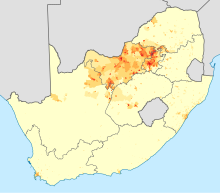
Back Tswana Afrikaans त्सवाना भाषा ANP اللغة التسوانية Arabic التسوانيه (لغه) ARZ Tswana AST Tsvana dili Azerbaijani Тсвана (мова) Byelorussian Тсвана Bulgarian Tswaneg Breton Tswana Catalan
| Tswana | |
|---|---|
| Setswana | |
| Native to | |
| Ethnicity | Batswana |
Native speakers | (4.1 million in South Africa (2011) 1.1 million in Botswana cited 1993)[1] unknown numbers in Namibia and Zimbabwe 7.7 million L2 speakers in South Africa (2002)[2] |
| Dialects |
|
| Latin (Tswana alphabet) Tswana Braille Ditema tsa Dinoko | |
| Official status | |
Official language in | |
Recognised minority language in | |
| Language codes | |
| ISO 639-1 | tn |
| ISO 639-2 | tsn |
| ISO 639-3 | tsn |
| Glottolog | tswa1253 |
| Linguasphere | 99-AUT-eg |
| Tswana | |
|---|---|
| Person | Motswana |
| People | Batswana |
| Language | Setswana |
| Country | Botswana |



Tswana, also known by its native name Setswana, and previously spelled Sechuana in English, is a Bantu language spoken in and indigenous to Southern Africa by about 8.2 million people.[1] It is closely related to the Northern Sotho and Southern Sotho languages, as well as the Kgalagadi language and the Lozi language.[3]
Setswana is an official language of Botswana, South Africa, and Zimbabwe. It is a lingua franca in Botswana and parts of South Africa, particularly North West Province. Tswana speaking ethnic groups are found in more than two provinces of South Africa, primarily in the North West, where about four million people speak the language. An urbanised variety is known as Pretoria Sotho, and is the principal unique language of the city of Pretoria. The three South African provinces with the most speakers are Gauteng (circa 11%), Northern Cape, and North West (over 70%). Until 1994, South African Tswana people were notionally citizens of Bophuthatswana, one of the bantustans of the apartheid regime. The Setswana language in the Northwest Province has variations in which it is spoken according to the ethnic groups found in the Tswana culture (Bakgatla, Barolong, Bakwena, Batlhaping, Bahurutshe, Bafokeng, Batlokwa, Bataung, and Batswapong, among others); the written language remains the same. A small number of speakers are also found in Zimbabwe (unknown number) and Namibia (about 10,000 people).[1]
- ^ a b c Tswana at Ethnologue (18th ed., 2015) (subscription required)
- ^ Webb, Victor N. (2002). Language in South Africa: The Role of Language in National Transformation, Reconstruction and Development. Philadelphia: John Benjamins. p. 78. ISBN 978-90-272-9763-1.
- ^ Makalela, Leketi (2009). "Harmonizing South African Sotho Language Varieties: Lessons From Reading Proficiency Assessment". International Multilingual Research Journal. 3 (2): 120–133. doi:10.1080/19313150903073489. S2CID 143275863.